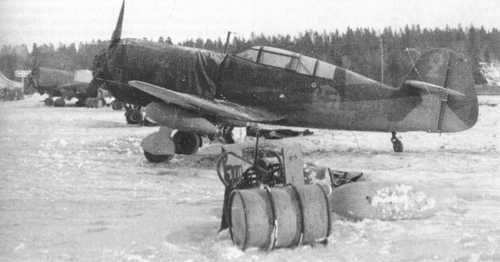
The Finnish Storm
A VL Myrsky (Storm) during the Soviet-Finnish war. The VL Myrsky was a finnish world war 2 fighter. The decision to start developing a new fighter for the Finnish Air Force was based on experience gained before the Winter War: in the "arms race" leading up to a war, it can be difficult for smaller nations to purchase top-of-the-range fighters without a significant political cost. The Finnish Air Force requested preliminary proposals for a domestic fighter from State Aircraft Factory (Valtion Lentokonetehdas) in early 1939, before the Winter War. State Aircraft Factory prepared five alternative proposals by May 1939. After that, The Ministry of Defence ordered the fighter design from State Aircraft Factory in June 1939. The preliminary design was made by the aircraft-designer trio Arvo Ylinen (head of the design-bureau), Martti Vainio (aerodynamics), and Torsti Verkkola (structural design). Edward Wegelius was appointed head of the design department of the State Aircraft Factory when Ylinen later moved on to the Helsinki University of Technology in August 1940. VL did not appoint any main constructor to its products, such as the German aircraft manufacturers did. Due to difficulties obtaining duraluminium, the wings were made out of plywood and the fuselage was metal structure with fabric or plywood coating. The planned Bristol Taurus III engine was not available due to war, so a Pratt & Whitney R-1830 (civil Twin Wasp) was chosen. Availability of this engine was also problematic, so an R-1830-S3C3-G was used for the first prototype and less-powerful SC3-Gs for later prototypes and production fighters. These were bought from German war booty stocks. The first Myrsky I prototype flew on 23 December 1941.[1] The prototype was fully functional, but too heavy. After some modifications they soon had three new prototype aircraft. The test flights showed some problems with the structural strength during high speed tests. All three prototypes were destroyed during test flights; two test pilots died, one was seriously injured. Series production started after German deliveries of Messerschmitt Bf 109 had begun in 1943. The series production version was called Myrsky II. 47 Myrsky IIs were built and together with the Myrsky I version the production amounted to 51 in all. Although the aircraft met the specifications set for it, it did not fulfill all expectations due to structural problems. The Myrsky III was ordered in spring 1943, but none were built. Reconnaissance Squadron 12 received their first Myrskys during August 1944. Thirty Myrskys were delivered to Reconnaissance Squadrons 12 and 16 before the end of the Continuation War. Fifteen Myrsky fighters flew 68 missions during the Continuation War. During one mission, they met Soviet Yak-7s, but the fight ended without losses for either side. During two other missions, Myrskys damaged two Soviet fighters, which both were destroyed on landing. Six Myrskys took part in a bombing mission on September 3, 1944, destroying 11 Polikarpov U-2 reconnaissance aircraft on ground. During the Lapland War, six Myrskys flew 13 reconnaissance missions between March 2 and March 23, 1945. The wooden construction proved problematic in this theatre, not enduring wet weather or cold well. The war time Lukko glue, manufactured from ersatz materials, which was used for gluing the wooden parts, did not stand rain, frost and humidity, and the glue seams disintegrated, sometimes with disastrous results. Ten Myrskys were lost in accidents between 1943–1947 and four pilots died. Myrsky usage ended in May 1947 and the last Myrsky flight was in February 1948. The Myrsky proved fast and manoeuvrable enough to dogfight the contemporary Soviet aircraft; it was the second fastest Finnish Air Force airplane after the Messerschmitt Bf 109G. Its aerodynamic design was excellent, and was later used on VL Pyörremyrsky fighter and Valmet Vihuri trainer. Its wide undercarriage gave it decent ground-handling properties. Its main drawback was the construction method: it simply did not stand the harsh Finnish weather.
This is a companion discussion topic for the original entry at https://www.ww2incolor.com/gallery/finnish-forces/49951/the-finnish-storm
